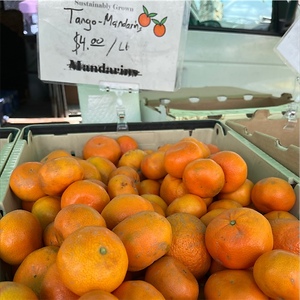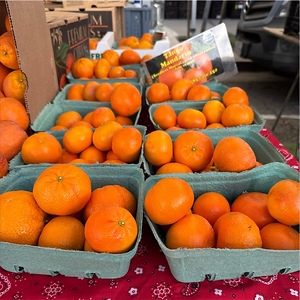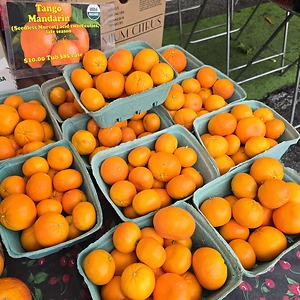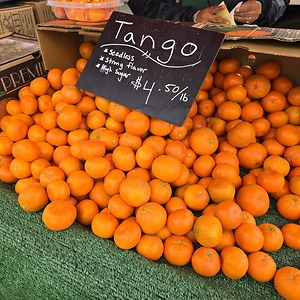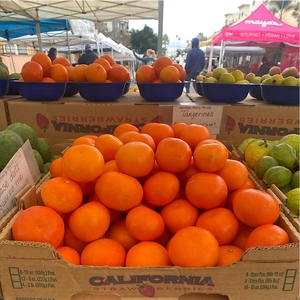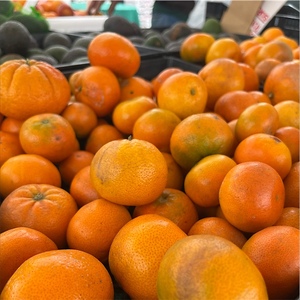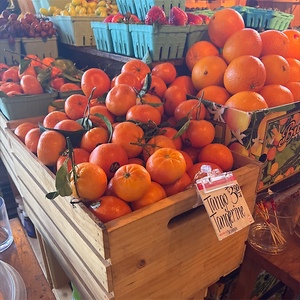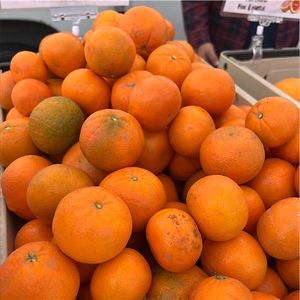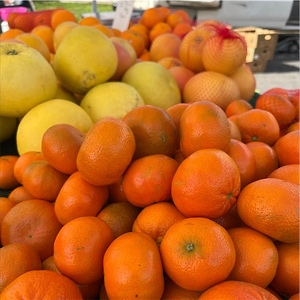

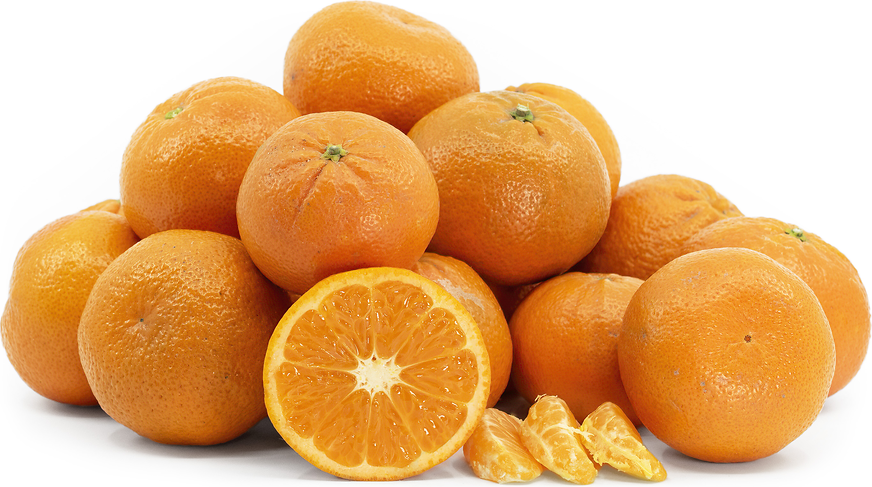
Tango Tangerines
Estimated Inventory, lb : 0
Description/Taste
Tango tangerines are a medium to large variety, averaging 5 to 6 centimeters in diameter, and have an oblate to flattened, curved shape. The rind is thin, smooth, dark orange, and glossy, sometimes coated in a light layer of food-grade wax to seal in moisture, and is covered in many small oil glands releasing fragrant essential oils. The rind is also taut but has a slight give to it when pressed and can be easily peeled, revealing 9 to 12 segments of orange flesh divided by very thin membranes. The flesh is tender, succulent, and aqueous, comprised of soft, tiny juice-filled sacs, and the fruits are mostly found seedless. Tango tangerines are harvested when ripe and contain moderate sugar and acidity levels, contributing to a vibrant sweet, tart, and tangy flavor.
Seasons/Availability
Tango tangerines are available in the late winter through spring.
Current Facts
Tango tangerines, botanically classified as Citrus reticulata, are a late-season variety belonging to the Rutaceae or citrus family. The squat, oblate fruits are also known as Tango mandarins and grow on trees that can reach up to three meters in height. Tango tangerines were developed from selective breeding through the University of California Riverside’s Citrus Breeding Program in the early 21st century and were produced to create a seedless tangerine with rich flavors. Since the cultivar’s release, Tango tangerines have become a favored variety among California growers as the trees are prolific, and the fruit can hold well to the tree for 3 to 4 months. In commercial markets, Tango tangerines are favored by consumers for their juicy nature and fresh, sweet-tart taste.
Nutritional Value
Tango tangerines are an excellent source of vitamin C, an antioxidant that reduces inflammation, strengthens the immune system, and boosts collagen production within the body. The tangerines are also a good source of vitamin A to maintain healthy organ functioning, fiber to regulate the digestive tract and contain lower amounts of folate, potassium, calcium, iron, and magnesium.
Applications
Tango tangerines have a balanced, sweet-tart flavor best suited for both fresh and cooked applications. It is important to note that tangerines do not ripen off of the tree and should be fully mature before harvest. The fruit’s flesh is moderately adhered, making the rind easy-to-peel, and once peeled and segmented, the flesh can be consumed straight out-of-hand, tossed into green salads, or mixed into fruit bowls. Tango tangerines can also be blended into smoothies, pressed into juice for vinaigrettes, dipped in chocolate as a sweet treat, or chopped into salsas. Beyond fresh applications, the fruits can be cooked into sauces, syrups, glazes, jams, and jellies, juiced and stirred into cocktails, fruit punches, and sparkling beverages, or cooked with roasted meats as a savory-sweet main dish. The tangerines can also be incorporated as flavoring into tarts, cakes, muffins, cookies, and sorbet. Tango tangerines pair well with meats such as poultry, pork, and ham, seafood, arugula, herbs such as basil, mint, and parsley, turmeric, ginger, chocolate, and fruits such as grapefruit, strawberries, blueberries, and apples. Fresh whole Tango tangerines will keep for two weeks when stored in a plastic bag in the refrigerator’s crisper drawer.
Ethnic/Cultural Info
The San Joaquin Valley in California produces over ninety percent of the mandarins sold domestically in the United States. The valley is considered one of the most productive agricultural zones, labeled as the American fruit or salad bowl, and local products from the region include fresh fruits, vegetables, nuts, honey, wine, and olive oil. In the late 1990s, mandarins first became popular in the United States from Spanish imports of the fruit. To compete with the increasing demand, two California citrus companies, Wonderful Citrus and Sun Pacific, began planting mandarins in an effort to meet consumer needs for easy-to-peel, juicy, and mostly seedless fruits. Mandarins grown from these fields were labeled in commercial markets as halos and cuties, quickly establishing mandarins as a favored American snack. In the modern-day, mandarins have become a common household fruit, and since Tango tangerines are not a trademarked name, the variety is often sold under more commercial names such as cuties and delites.
Geography/History
Tango tangerines were developed at the University of Riverside’s Citrus Breeding Program from W. Murcott mandarins. In 1995, budwood of the W. Murcott citrus was irradiated, spurring the branches to mutate and develop new characteristics from the parent variety. Each budwood tested produced slightly different mutations, and one branch displayed fruits that contained all the favorable attributes of the W. Murcott mandarin in addition to being found seedless. This sample was extensively studied and grafted onto rootstocks for expanded cultivation in 1996. After multiple fruiting seasons, the developed cultivar was named Tango in 2000 and was registered in the UC Citrus Clonal Protection Program. Tango tangerines were first released to California growers in 2006 and were later introduced to Florida growers in 2007. In 2009, the fruits were available under exclusive licenses to growers worldwide. Today Tango tangerines are found through farmer’s markets and specialty grocers across the United States, Europe, and Australia.
Recipe Ideas
Recipes that include Tango Tangerines. One



